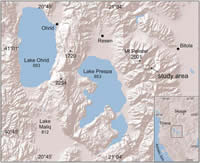An Oldest Dryas glacier expansion on Mount Pelister (Former Yugoslavian Republic of Macedonia) according to 10Be cosmogenic dating
Ribolini A., M. Bini, I. Isola, M. Spagnolo, G. Zanchetta, R. Pellitero, S. Mechernich, R. Gromig, T. Dunai, B. Wagner and I. Milevski (2017).
Journal of the Geological Society, https://doi.org/10.1144/jgs2017-038.
Introduction
We provide a geomorphological analysis of a glacial valley on Mount Pelister, in Macedonia. Three boulders from a frontal moraine were dated with the cosmogenic nuclide isotope 10Be. The results demonstrate that the boulders have been exposed since 15.24 ± 0.85 ka. This age constrains the formation of the frontal moraine to the Oldest Dryas cold event. This age fits with that of other glacier deposits dated to the Older Dryas in the Alps, Balkans, Carpathians and Turkish mountains. The Pelister palaeoglacier has been reconstructed and its equilibrium line altitude extracted, returning a value of 2250 m a.s.l. This is in good agreement with the equilibrium line altitudes of most other reconstructed glaciers of the same age in the circum-Mediterranean mountains, demonstrating a comparable response to the Oldest Dryas event. Other palaeoenvironmental records near the Pelister mountain indicate that the Older Dryas was here characterized by a cold and remarkably dry event. The temporal relationship between Older Dryas glacier advances in the Balkan region and recorded changes in the Atlantic thermohaline circulation during the Laurentide Ice Sheet massive ice discharge (H1 event) confirms the strong climatic link between the pan-Mediterranean regions and the North Atlantic Ocean.
http://jgs.lyellcollection.org/content/early/2017/07/20/jgs2017-038


